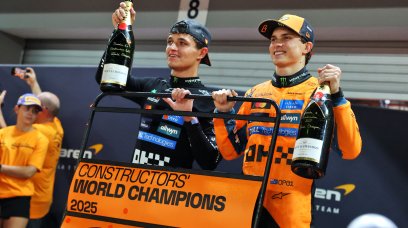The 2022 F1 season welcomed a new wave of regulations designed specifically to aid close racing and overtaking. This was facilitated by the legalising of ground effect aerodynamics, a method of creating downforce not seen since it was banned in 1983 for safety reasons. Ground effect works by directing the air flow on the underside of the car in such a way that creates an area of low pressure. This low pressure effectively sucks the car to the road, generating downforce from under the car. However, issues with dangerously high cornering speeds and porpoising - where the car starts bouncing - resulted in ground effect eventually being banned. Competing in Formula 1 for numerous teams from 1979 to 1986, Marc Surer raced in one of the most innovative eras of the sport. With 88 Grand Prix entries and thousands of miles of F1 testing under his belt, Surer witnessed the best - and worst - of the previous ground effect generation of cars before they were banned for 1983. In an exclusive interview with RacingNews365 , Surer recalls the performance and dangers of the increasingly powerful effect. Given the problematic history with ground effect in the 70s and 80s, the Swiss was surprised to see so many teams struggling with the porpoising problem, given the sophisticated methods of designing modern F1 cars. "I was surprised that they didn't find out about it in the wind tunnel, because now it [car development] is all simulation," said Surer. "I enjoy that actually; you only find out when you drive the car on the track. In all the simulation they didn't see that. I love that because at least it gives a reason to test the car on the track and not just bring a car from the simulation to the track and it wins races. "The channels under the car are much better than what we have. We had some of these profiles to the left and right sides of the chassis, like a wing profile, and now they have real [detailed] channels that control the air much better, and of course that gives even more downforce."
How the porpoising problem was solved in previous ground effect cars
The porpoising issue for the 2022 cars was apparent straight away in pre-season testing, with very few teams escaping the dramatic bouncing effect ahead of the new season. Reigning Constructors' Champions Mercedes were one of the biggest victims, and much of their early season development has been focussed on trying to eliminate the bouncing from their cars. Using swathes of data gathered from the opening few races, Mercedes were able to bring new bodywork to the Spanish Grand Prix and vastly reduce a lot of their porpoising issues. This was despite a lack of in-season testing and a cost cap. In the previous ground effect era with comparatively open regulations compared to today, F1 teams were unable to rely on simulations to develop their way out of a problem. Instead, teams relied more on hand calculations, track testing and trial-and-error to fix the aerodynamic issues they faced. Surer is well-placed to explain how Formula 1 teams of the 1980s operated, having raced for Ensign, ATS, Theodore, Arrows and Brabham. "I remember the porpoising, and it was sometimes so bad that we had to lift off on the straights because the cars started to jump, with the front wheels taking off from the ground," said Surer. "It was porpoising in a really big way, and the engineers had to work on that. There were two different ways; one is to take the pressure away from under the car, because when the car sucks down the air stalls, and then it jumps up, and so they had to release the air. "So we had these moving [side] skirts and you could drill some holes into them, and some teams tried with different holes. "One important step was also to make the suspensions stiffer. I remember even Williams once tried with no suspension, or just made the suspension completely stiff, which didn't work when you hit the kerb, but it solved the problem of the porpoising. "I had [ex-F1 designer and engineer] Gustav Brunner working for ATS at this time and he was very good in aerodynamics. We got it under control quite quickly, but I remember seeing others having this problem and when you see the car in front of you bouncing you know you can out-brake them in the next corner if you wanted to. "If you got rid of it, even losing a little bit of downforce by putting holes into some areas, it was fantastic to then see the others fighting against it. Because of Brunner we had a good engineer in aerodynamics and he found a solution quickly."
Surer: The dangers forced us to take action
Naturally, the implementation and development of ground effect cars was pursued with one purpose in mind: reducing lap time. The Lotus team are credited with creating the breakthrough cars which took full advantage of ground effect aerodynamics. Their developments across the late 70s resulted in Formula 1's first ground effect championship-winning car, the Lotus 79. As ever with Formula 1, the development race intensified, with cars and drivers being pushed to greater limits. Limits which ultimately became too much for Formula 1. "We had [Williams F1 engineer] Frank Dernie once say that we had four-and-a-half G [of cornering force] already then," said Surer. "We had aluminium chassis and our car was not made for that. We had movement in the chassis itself because it was not strong enough from the bouncing and also from the G-force because he had so much G-force in the corner, which was not [suitable] for the aluminium chassis. It was impossible." "We had the skirts, but if the skirts didn't really stick to the ground and the car jumps when you hit something then you suddenly have no downforce anymore and you spun. "So we wanted to get rid of that. In the GPDA [Grand Prix Drivers' Association] we were fighting to get rid of this regulation, because it was too much G-force and the cars were not made for it. This was a dangerous path."
Most read









